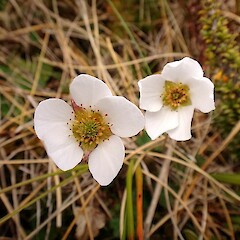Geum uniflorum
Common name
alpine avens
Synonyms
Oncostylus uniflorus (Buchanan) F.Bolle
Family
Rosaceae
Flora category
Vascular – Native
Endemic taxon
Yes
Endemic genus
No
Endemic family
No
Structural class
Herbs - Dicotyledons other than Composites
NVS code
The National Vegetation Survey (NVS) Databank is a physical archive and electronic databank containing records of over 94,000 vegetation survey plots - including data from over 19,000 permanent plots. NVS maintains a standard set of species code abbreviations that correspond to standard scientific plant names from the Ngä Tipu o Aotearoa - New Zealand Plants database.
GEUUNI
Chromosome number
2n = 42
Current conservation status
The conservation status of all known New Zealand vascular plant taxa at the rank of species and below were reassessed in 2017 using the New Zealand Threat Classification System (NZTCS) – more information about this can be found on the NZTCS website. This report includes a statistical summary and brief notes on changes since 2012 and replaces all previous NZTCS lists for vascular plants.
Please note, threat classifications are often suggested by authors when publications fall between NZTCS assessment periods – an interim threat classification status has not been assessed by the NZTCS panel.
- Conservation status of New Zealand indigenous vascular plants, 2017 . 2018. Peter J. de Lange, Jeremy R. Rolfe, John W. Barkla, Shannel P. Courtney, Paul D. Champion, Leon R. Perrie, Sarah M. Beadel, Kerry A. Ford, Ilse Breitwieser, Ines Schönberger, Rowan Hindmarsh-Walls, Peter B. Heenan and Kate Ladley. Department of Conservation. Source: NZTCS and licensed by DOC for reuse under the Creative Commons Attribution 4.0 International licence.
2017 | Not Threatened
Previous conservation statuses
2012 | Not Threatened
2009 | Not Threatened
2004 | Not Threatened
Distribution
Endemic. New Zealand. South and Stewart Islands
Habitat
Subalpine to alpine (up to 1800 m a.s.l.). In herbfield, on rock ledges, and in moist tussock grassland
Detailed description
Low-growing, loosely mat-forming, strongly rhizomatous herb up to 200 mm tall at flowering, arising from a ± stout, initially fleshy, ultimately woody stock. Basal leaves up to 120 mm long, imparipinnate, glossy dark green fading to dark red, areolate, glabrate to moderately pilose, margins lobulate-crenate, undulose, fringed with a dense covering of harsh golden yellow hairs, hydathodes white, conspicuous; lateral leaflets in 1-2(-5) pairs, all very reduced and lowest rudimentary; terminal leaflet 10-40 mm long, crenate-dentate and sometimes obscurely lobed; cauline leaves reduced to small, toothed bracts. Scape up to 200 mm long, finely pubescent, intermixed with longer, wispy, multicellular glandular hairs. Flowers solitary, up to 25 mm diameter. Calyx pubescent and villous, lobes c.6 mm long, narrow-ovate, bracteoles minute, deeply bifid. Petals 7-17 mm long, white or creamy white, broadly ovate. Disc crimson. Anthers purple. Achenes numerous, c. 2 mm. long, densely pilose especially on margins; style remnant c.5 mm long, apex hooked.
Similar taxa
Allied to Geum divergens Cheeseman with which it shares a strongly rhizomatous growth habit and large flowers. From that species it is distinguished by its smaller overall dimensions, open, leafy rosettes; leaves which are adaxially areolate, glossy dark green fading to dark red with age; with more or less undulate, lobulate-crenate leaf margins which are fringed with dense golden hairs and conspicuous white hydathodes; pubescent petioles and peduncles with intermixed longer multicellular glandular hairs; and solitary white flowers up to 25 mm diameter, with a central crimson eye, ringed with purple anthers.
Flowering
November - February
Flower colours
Cream, White
Fruiting
December - March
Life cycle
Pappate achenes are dispersed by wind (Thorsen et al., 2009).
Propagation technique
Easily grown in pots in an alpine house, and in cooler climates within a rock garden. Best grown from fresh seed.
Etymology
geum: Possibly from the Greek geuo ‘to give a pleasant flavour’, the roots of some species being aromatic.
uniflorum: One flowered
Where To Buy
Not Commercially Available.
Attribution
Description adapted from Allan (1961) and Webb et al. (1988)
References and further reading
Allan, H.H. 1961: Flora of New Zealand. Vol. I. Government Printer, Wellington
Thorsen, M. J.; Dickinson, K. J. M.; Seddon, P. J. 2009. Seed dispersal systems in the New Zealand flora. Perspectives in Plant Ecology, Evolution and Systematics 11: 285-309
Webb, C.J.; Sykes, W.R.; Garnock-Jones, P.J. 1988: Flora of New Zealand. Vol. IV. Naturalised Pteridophytes, Gymnosperms, Dicotyledons. 4. Christchurch, New Zealand, Botany Division, D.S.I.R.






